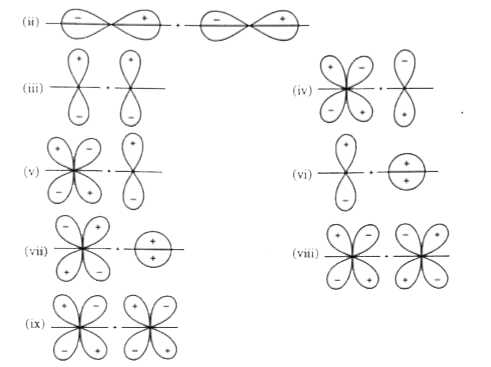Which are the type of molecular orbitals ? Give information in short.
Molecular orbitals of diatomic molecules are designated or (sigma), (Pi) (Delta) etc.
(sigma) molecular orbitals: The sigma molecular orbitals are symmetrical around the bond axis.
e.g. : The linear combination of 1s orbitals centered on two nuclei produces two molecular orbitals which are symmetrical around the bond-axis. Such molecular orbitals are of the o type and are designed as ols and 1 s and eg. and : If internuclear axis is taken to be in the Z-direction, it can be seen that a linear combination of orbitals of two atoms also produces two sigma molecular orbitals designated or are types ad symmetrical around the bond axis.
types molecular orbitals : The molecular orbitals are not symmetrical around the bond axis because in these above and below the bond axes (+) and (- ) symbol are not symmetrical.
Molecular orbitals obtained form orbitals are not symmetrical around the bond axis because of the presence of positive lobes above and negative lobes below the molecular plan. Such molecular orbitals are labelled as .
A bonding MO has larger electron density above and below the inter nuclear axis.
The antibonding MO has a node between the nuclei.
Topper's Solved these Questions
- CHEMICAL BONDING AND MOLECULAR STRUCTUREBOOK - KUMAR PRAKASHANCHAPTER - CHEMICAL BONDING AND MOLECULAR STRUCTUREEXERCISE - TRY YOUR SELF-3
1 Videos
- CHEMICAL BONDING AND MOLECULAR STRUCTUREBOOK - KUMAR PRAKASHANCHAPTER - CHEMICAL BONDING AND MOLECULAR STRUCTUREEXERCISE - TRY YOUR SELF-4
1 Videos
- CLASSIFICATION OF ELEMENTS AND PERIODICITY IN PROPERTIES BOOK - KUMAR PRAKASHANCHAPTER - CLASSIFICATION OF ELEMENTS AND PERIODICITY IN PROPERTIES EXERCISE - Section -D SOLUTIONS OF NCERT EXEMPLAR PROBLEMS (Long Answer Type Questions )
7 Videos
Similar Questions
There are some arrangements of atomic orbitals which are given below:

 Then calculate the value of "QtimesR-P'" where P, Q and R are no. of arrangements which give bonding molecular orbitals (positive overlap), antibonding molecular orbitals (negative overlap) and non-bonding molecular orbitals (zero overlap) respectively.
Then calculate the value of "QtimesR-P'" where P, Q and R are no. of arrangements which give bonding molecular orbitals (positive overlap), antibonding molecular orbitals (negative overlap) and non-bonding molecular orbitals (zero overlap) respectively.
View SolutionMolecular orbital theory, shapes of molecular orbitals
View Solution
Knowledge Check
Molecular orbital theory is based on linear combination of atomic orbitals (LCAO). According to LCAO when respective atomic orbitals of the atoms interact, they undergo constructive and destructive interference giving rise to two types of molecular orbitals, that is, bonding and antibonding molecular orbitals.
If z is the molecular axis then which of the following overlapping results in non-bonding molecular orbital?A(dx2−y2+dx2−y2)B(dxy+dxy)C(dyz+py)D(dxy+pz)Molecular orbital theory is based on linear combination of atomic orbitals (LCAO). According to LCAO when respective atomic orbitals of the atoms interact, they undergo constructive and destructive interference giving rise to two types of molecular orbitals, that is, bonding and antibonding molecular orbitals.
Calculate the bond order and magnetic nature of the F2+2, if sp intermixing is not considered and Hund's rule is also violated.A1, diamagneticB1, paramagneticC2, paramagenticD2, diamagneticWhich of the following molecular orbital has the lowest energy ?
Aσ2pzBσ∗2pzCπ∗2pxDπ∗2py
Which of the following molecular orbitals has the lowest energy?
View SolutionMolecular orbital theory as developed by Hund and Mulliken concerns with the formation of molecular orbitals formed by linear combination of atomic orbitals. The electrons are present in these molecular orbitals. The molecular orbitals are filled. The molecular orbital configuration helps us to calculate bond order which gives information about the number of bonds present between atoms. The bond order is related to bond length and bond strength.
Which of the following combination does ot give σ MO (assume Z - axis as internuclear axis)
View SolutionMolecular orbital theory as developed by Hund and Mulliken concerns with the formation of molecular orbitals formed by linear combination of atomic orbitals. The electrons are present in these molecular orbitals. The molecular orbitals are filled. The molecular orbital configuration helps us to calculate bond order which gives information about the number of bonds present between atoms. The bond order is related to bond length and bond strength.
Which one of the following does not have single electron in a bonding molecular orbital?
View SolutionMolecular orbital theory as developed by Hund and Mulliken concerns with the formation of molecular orbitals formed by linear combination of atomic orbitals. The electrons are present in these molecular orbitals. The molecular orbitals are filled. The molecular orbital configuration helps us to calculate bond order which gives information about the number of bonds present between atoms. The bond order is related to bond length and bond strength.
Which of the following will have maximum number of electrons in antibonding MOs?
View SolutionMolecular orbital theory as developed by Hund and Mulliken concerns with the formation of molecular orbitals formed by linear combination of atomic orbitals. The electrons are present in these molecular orbitals. The molecular orbitals are filled. The molecular orbital configuration helps us to calculate bond order which gives information about the number of bonds present between atoms. The bond order is related to bond length and bond strength.
Which of the following is expected to have largest bond length?
View Solution
